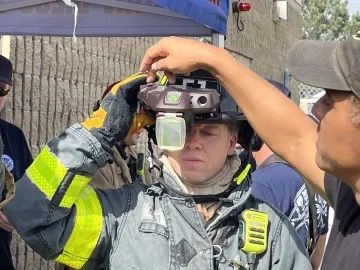The Department of Homeland Security (DHS) Science and Technology Directorate (S&T) announced that interested fire departments across the country can now apply to test an innovative new fire safety tool: a helmet-mounted, indoor visualisation and navigation device that allows first responders to see through dark smoke.
Developed by Austin, Texas-based startup Qwake Technologies, this protype—known as C-THRU—aims to improve situational awareness, increasing the speed and effectiveness of firefighters while reducing their exposure to carcinogenic environments. A $4.7 million funding award from S&T will finance the production of 400 C-THRU devices for standardised testing in diverse firefighting environments and scenarios, with applications due by July 31, 2024. Data from testing will inform product refinement and real-world optimization, leading up to commercial release.
Firefighters frequently face unfamiliar environments under dangerous and challenging conditions. Prolonged exposure to dark, dense smoke can lead to disorientation, making it harder for first responders to locate exit routes and locate those in harm’s way. Developed under S&T’s First Responder Capability program with Qwake Technologies as part of a 2020 contract to develop innovative fire safety technology, C-THRU helps firefighters more effectively carry out their jobs.
“We know improved equipment and technology for first responders will help save lives and protect firefighters,” said Dr. Dimitri Kusnezov, DHS Under Secretary for Science and Technology.
“Through collaborative partnerships with industry, S&T supports the development of devices like C-THRU that address challenges we know exist for first responders, and we’re leveraging emerging technology to meet their most urgent needs.”
The C-THRU device is hands-free, light weight and balanced. The system contains a high-speed thermal camera, mounted to the C-THRU device and similar to those firefighters currently use, which captures surroundings. The device’s computer processor uses artificial intelligence capabilities to provide enhanced vision and directional guidance to exits, victims, downed firefighters, and can identify walls, furniture or other obstacles.
C-THRU is cellular connected, and the thermal camera simultaneously livestreams a firefighter’s line of vision to incident commanders outside the fire for real-time support or post-incident review.
Along with providing a clearer, real-time view of an environment, C-THRU also helps reorient firefighters with navigation for backtracking that provides turn-by-turn guidance. If a firefighter does become lost in a burning building, a mayday function can be activated, which alerts other C-THRU wearers in the area to find the distressed first responder.
Similar to a smartphone, the system will continuously improve with over-the-air software updates. Qwake has developed and tested more than ten prototype versions since 2015, and began working with S&T in 2020, addressing the ‘holy grail’ challenge of stand-alone indoor navigation. Through a contract with Qwake, S&T has provided contractual funding and expert oversight in support of the research and development of C-THRU. The organisations began working with a select group of first response teams participating in operational field tests in the following years.








